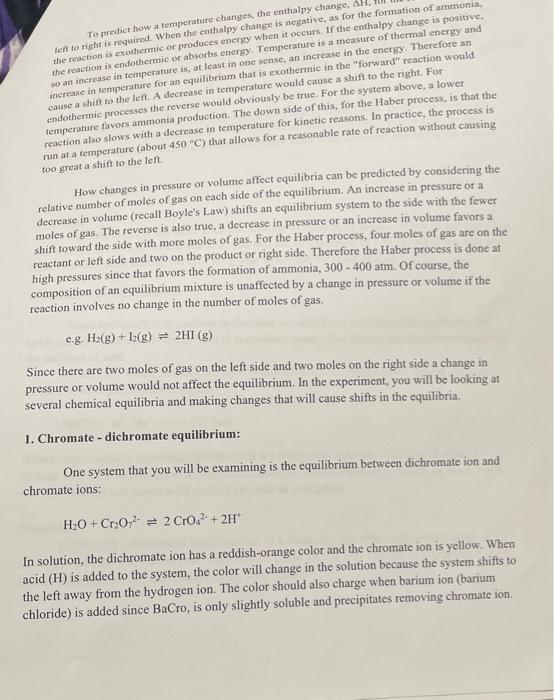To prediet how a temperature clanges, the enthalpy tef to right is required. When the enthalpy change is negative. as a it occurs the reaction is exothemermic or absorbs energy. Temperature is a measure of thermal energy and the reaction is endotherature is, at least in one sense, an increase in the energy. Therefore an so an inerease in temaperate for an equilibrium that is exothemic in the "forward" reaction would increase in temperateft. A decrease in temperature would cause a shift to the right. For cause a shim to processes the reverse would obviously be true. For the system above, a lower endotherruic procers ammonia production. The down side of this, for the Haber process, is that the temperature favors with a decrease in temperature for kinetic reasons. In practice, the process is reaction absostorature (about 450C) that allows for a reasonable rate of reaction without causing too great a shift to the left. How changes in pressure or volume affect cquilibria can be predicted by considering the relative number of moles of gas on each side of the equilibrium. An increase in pressure or a decrease in volume (recall Boyle's Law) shifts an equilibrium system to the side with the fewer moles of gas. The reverse is also true, a decrease in pressure or an increase in volume favors a shift toward the side with more moles of gas. For the Haber process, four moles of gas are on the reactant or left side and two on the product or right side. Therefore the Haber process is done at high pressures since that favors the formation of ammonia, 300400atm. Of course, the composition of an equilibrium mixture is unaffected by a change in pressure or volume if the reaction involves no change in the number of moles of gas. e. g. H2(g)+I2(g)2HI(g) Since there are two moles of gas on the left side and two moles on the right side a change in pressure or volume would not affect the equilibrium. In the experiment, you will be looking at several chemical equilibria and making changes that will cause shifts in the equilibria. 1. Chromate - dichromate equilibrium: One system that you will be examining is the equilibrium between dichromate ion and chromate ions: H2O+Cr2O722CrO42+2H+ In solution, the dichromate ion has a reddish-orange color and the chromate ion is yellow. When acid (H) is added to the system, the color will change in the solution because the system shifts to the left away from the hydrogen ion. The color should also charge when barium ion (barium chloride) is added since BaCro, is only slightly soluble and precipitates removing chromate ion







